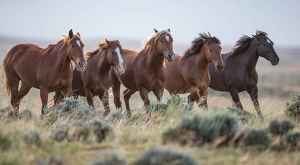as published on Popular Photography
“Our own Carol Walker, Director of Field Documentation at Wild Horse Freedom Federation, kindly shares some really neat tricks and tips on how to document the beauty that is our wild horses and burros. Please visit Popular Photography to see her handywork.” ~ R.T.
Walker is an expert in highlighting the beauty of horses

Carol Walker:
At McCullough Peaks Herd Management Area in Wyoming, Walker caught a family of wild horses in early morning with a Canon EOS-1D X and 600mm f/4L IS II Canon EF lens. Exposure was 1/1000 at f/4, ISO 1250.
Having photographed equine subjects professionally for more than 15 years, Carol Walker can tell at a glance whether a pictured horse is domestic or wild. “The domestics are usually very clean and shiny,” she says. “Their manes are untangled, and they’re prettier. The wild horses have a more rustic look—they’re just dirty,” she adds with a laugh. “They might have matted hair, and they look rougher. But they’re gorgeous when they’re galloping in the wild.”
Walker has an affinity for both types. “I’ve loved horses since I was a little girl, and I’ve ridden them all my life,” she says. “The more you know about your subject, the better photographs you’re going to get. With horses, I know how to predict what they’re going to do and how to work with them.”
A resident of Longmont, Colorado, Walker is a fervent advocate for the preservation of wild horses in the American West. “Right now our wild horses are getting squeezed out by very powerful interest groups such as cattle and oil and gas, so they’re disappearing,” she says. “I’ve been fighting to try to keep them wild. It’s a tough fight.”
Walker’s recent self-published book, Galloping to Freedom ($40; wildhoofbeats.com) is sponsored and partially funded by Cana Projects, a wildlife preservation foundation. “It’s about a group of horses that were rounded up in Wyoming,” Walker says of the book. “They were all separated from their families, then reunited at the Black Hills Wild Horse Sanctuary. So it’s a true story with a happy ending.”
The key difference between photographing wild horses and domestic ones? In a word: control. “Wild horses are a challenge because you can’t say, ‘Move over here, the background is better,’” Walker says. “You have to anticipate where they are going and put yourself in a good position—and then it’s luck. With domestics you can say, ‘Let’s go over here,’ and it’s much easier.”
For the latter, a handy tool is the universal lure of food. “Sometimes I have a can with grain in it and shake it—horses are very food-oriented so they’ll jump to attention,” Walker says. “Then I usually get the owner to turn the horse loose out where it’s safe so they can run, because that’s where you get the best pictures. I enjoy action shots.”
For the photo on our opening spread, a trio of domestic horses were herded through water by riders outside the frame. “There were about five riders keeping them in place,” recalls Walker, who was leading a horse-photography workshop in the Camargue region of France. “They’re running through the water right in front of us, in late afternoon as the sun is setting.” Dressed in mud boots, she perched in the water with a monopod for her Canon EOS-1D X and a 200–400mm f/4L lens (with a built-in 1.4X extender). “The shot is staged, but it’s really cool to have several horses running in a line—you can’t get this under most circumstances.”
Horses in motion require fast shutter speeds; Walker shot at 1/800 sec. “For a horse walking, the minimum shutter speed is 1/500 sec and for running it’s 1/1000,” she advises. “If the horse is running directly toward you, you can do 1/500 sec. I set the camera on shutter priority with moving subjects, and then I raise or lower my ISO [800 here] depending upon the light.” Rather than use a manual light meter, the photographer relies on her camera’s exposure compensation. “For fast-moving horses,” she adds, “I use autofocus and autofocus lock.”…(CONTINUED)

http://www.popphoto.com/carol-walkers-tips-for-taking-majestic-horse-photographs
Categories: Horse News, The Force of the Horse









Great tips Carol. You are a great photographer who can catch the essence of beauty in the horse. I will try some of your tips. Horses are beautiful and pictures say a thousand words.
LikeLike
Thanks so much Vicki!
LikeLike
There really isn’t much more beautiful and elegant than a horse. Which makes the insensitive treatment of them that much worse.
LikeLike
Agreed They are such beautiful beings.The last living icons of our American West. Our western heritage that no other country has.
Makes me sick we are losing them..and for very stupid reasons and because of very stupid people who don’t know what their doing.
Ready to go kick some but.
Whatever happened to the Ole vigilantes?
LikeLike
Carol’s love for the Horses…THAT’S the Magic
Wild Hoofbeats: America’s Vanishing Wild Horses
LikeLike
McCullough Peaks Wild Horses Slideshow
CarolJWalker
LikeLike
Over 60 beautiful photos by Carol Walker of the wild horses living in the Adobe Town Herd Management Area in Wyoming grace this 2016 calendar. From the small foals to the powerful, mature stallions, Carol’s images capture the spirit and beauty of the wild horses in this Red Desert herd.
50% of all the proceeds from sales of this calendar will go to Wild Horse Freedom Federation
Now Available Here
http://www.wildhoofbeats.com/products/wild-horse-freedom-federation-annual-calendar
LikeLike